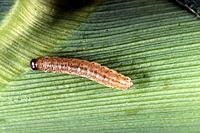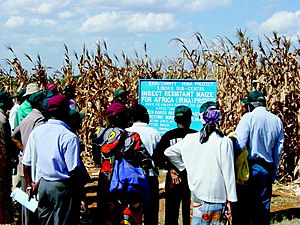Genetically modified maize facts for kids
Genetically modified maize (corn) is a genetically modified crop. Specific maize strains have been genetically engineered to express agriculturally-desirable traits, including resistance to pests and to herbicides. Maize strains with both traits are now in use in multiple countries. GM maize has also caused controversy with respect to possible health effects, impact on other insects and impact on other plants via gene flow. One strain, called Starlink, was approved only for animal feed in the US but was found in food, leading to a series of recalls starting in 2000.
Marketed products
Herbicide-resistant maize
Corn varieties resistant to glyphosate herbicides were first commercialized in 1996 by Monsanto, and are known as "Roundup Ready Corn". They tolerate the use of Roundup. Bayer CropScience developed "Liberty Link Corn" that is resistant to glufosinate. Pioneer Hi-Bred has developed and markets corn hybrids with tolerance to imidazoline herbicides under the trademark "Clearfield" – though in these hybrids, the herbicide-tolerance trait was bred using tissue culture selection and the chemical mutagen ethyl methanesulfonate, not genetic engineering. Consequently, the regulatory framework governing the approval of transgenic crops does not apply for Clearfield.
As of 2011, herbicide-resistant GM corn was grown in 14 countries. By 2012, 26 varieties of herbicide-resistant GM maize were authorised for import into the European Union, but such imports remain controversial. Cultivation of herbicide-resistant corn in the EU provides substantial farm-level benefits.
Insect-resistant corn

Bt maize/corn
Bt maize/Bt corn is a variant of maize that has been genetically altered to express one or more proteins from the bacterium Bacillus thuringiensis including Delta endotoxins. The protein is poisonous to certain insect pests. Spores of the bacillus are widely used in organic gardening, although GM corn is not considered organic. The European corn borer causes about a billion dollars in damage to corn crops each year.
In recent years, traits have been added to ward off corn ear worms and root worms, the latter of which annually causes about a billion dollars in damages.
The Bt protein is expressed throughout the plant. When a vulnerable insect eats the Bt-containing plant, the protein is activated in its gut, which is alkaline. In the alkaline environment, the protein partially unfolds and is cut by other proteins, forming a toxin that paralyzes the insect's digestive system and forms holes in the gut wall. The insect stops eating within a few hours and eventually starves.
In 1996, the first GM maize producing a Bt Cry protein was approved, which killed the European corn borer and related species; subsequent Bt genes were introduced that killed corn rootworm larvae.
The Philippine Government has promoted Bt corn, hoping for insect resistance and higher yields.
Approved Bt genes include single and stacked (event names bracketed) configurations of: Cry1A.105 (MON89034), CryIAb (MON810), CryIF (1507), Cry2Ab (MON89034), Cry3Bb1 (MON863 and MON88017), Cry34Ab1 (59122), Cry35Ab1 (59122), mCry3A (MIR604), and Vip3A (MIR162), in both corn and cotton. Corn genetically modified to produce VIP was first approved in the US in 2010.
A 2018 study found that Bt-corn protected nearby fields of non-Bt corn and nearby vegetable crops, reducing the use of pesticides on those crops. Data from 1976-1996 (before Bt corn was widespread) was compared to data after it was adopted (1996-2016). They examined levels of the European corn borer and corn earworm. Their larvae eat a variety of crops, including peppers and green beans. Between 1992 and 2016, the amount of insecticide applied to New Jersey pepper fields decreased by 85 percent. Another factor was the introduction of more effective pesticides that were applied less often.
Sweet Corn
GM sweet corn varieties include "Attribute", the brand name for insect-resistant sweet corn developed by Syngenta and Performance Series insect-resistant sweet corn developed by Monsanto.
Cuba
While Cuba's agriculture is largely focused on organic production, as of 2010, the country had developed a variety of genetically modified corn that is resistant to the palomilla moth.
Drought-resistant maize
In 2013 Monsanto launched the first transgenic drought tolerance trait in a line of corn hybrids called DroughtGard. The MON 87460 trait is provided by the insertion of the cspB gene from the soil microbe Bacillus subtilis; it was approved by the USDA in 2011 and by China in 2013.
Products in development
In 2007, South African researchers announced the production of transgenic maize resistant to maize streak virus (MSV), although it has not been released as a product. While breeding cultivars for resistance to MSV isn't done in the public, the private sector, international research centers, and national programmes have done all of the breeding. As of 2014, there have been a few MSV-tolerant cultivars released in Africa. A private company Seedco has released 5 MSV cultivars.
Research has been done on adding a single E. coli gene to maize to enable it to be grown with an essential amino acid (methionine).
Refuges
US Environmental Protection Agency (EPA) regulations require farmers who plant Bt corn to plant non-Bt corn nearby (called a refuge) to provide a location to harbor vulnerable pests. Typically, 20% of corn in a grower's fields must be refuge; refuge must be at least 0.5 miles from Bt corn for lepidopteran pests, and refuge for corn rootworm must at least be adjacent to a Bt field.
The theory behind these refuges is to slow the evolution of resistance to the pesticide. EPA regulations also require seed companies to train farmers how to maintain refuges, to collect data on the refuges and to report that data to the EPA. A study of these reports found that from 2003 to 2005 farmer compliance with keeping refuges was above 90%, but that by 2008 approximately 25% of Bt corn farmers did not keep refuges properly, raising concerns that resistance would develop.
Unmodified crops received most of the economic benefits of Bt corn in the US in 1996–2007, because of the overall reduction of pest populations. This reduction came because females laid eggs on modified and unmodified strains alike.
Seed bags containing both Bt and refuge seed have been approved by the EPA in the United States. These seed mixtures were marketed as "Refuge in a Bag" (RIB) to increase farmer compliance with refuge requirements and reduce additional work needed at planting from having separate Bt and refuge seed bags on hand. The EPA approved a lower percentage of refuge seed in these seed mixtures ranging from 5 to 10%. This strategy is likely to reduce the likelihood of Bt-resistance occurring for corn rootworm, but may increase the risk of resistance for lepidopteran pests, such as European corn borer. Increased concerns for resistance with seed mixtures include partially resistant larvae on a Bt plant being able to move to a susceptible plant to survive or cross pollination of refuge pollen on to Bt plants that can lower the amount of Bt expressed in kernels for ear feeding insects.
Resistance
Resistant strains of the European corn borer have developed in areas with defective or absent refuge management.
In November 2009, Monsanto scientists found the pink bollworm had become resistant to first-generation Bt cotton in parts of Gujarat, India – that generation expresses one Bt gene, Cry1Ac. This was the first instance of Bt resistance confirmed by Monsanto anywhere in the world. Bollworm resistance to first generation Bt cotton has been identified in Australia, China, Spain, and the United States. In 2012, a Florida field trial demonstrated that army worms were resistant to pesticide-containing GM corn produced by Dupont-Dow; armyworm resistance was first discovered in Puerto Rico in 2006, prompting Dow and DuPont to voluntarily stop selling the product on the island.
Regulation
Regulation of GM crops varies between countries, with some of the most-marked differences occurring between the US and Europe. Regulation varies in a given country depending on intended uses.
See also
 In Spanish: Maíz transgénico para niños
In Spanish: Maíz transgénico para niños


